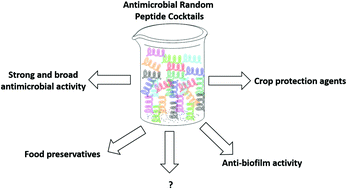Antimicrobial random peptide cocktails: a new approach to fight pathogenic bacteria
Abstract
Antibiotic resistance in bacteria has become a serious threat to public health, and therefore there is an urgent need to develop new classes of antimicrobial agents. Nowadays, natural antimicrobial peptides (AMPs) and their synthetic derivatives are considered as promising alternatives to traditional antibiotics. The broad molecular diversity of AMPs, in terms of sequences and structures, suggests that their activity does not depend on specific features of amino acid sequence or peptide conformation. We therefore selected two common properties of AMPs, (high percentage of hydrophobic and cationic amino acids), to develop a novel approach to synthesize random antimicrobial peptide mixtures (RPMs). Instead of incorporating a single amino acid at each coupling step, a mixture of hydrophobic and cationic amino acids in a defined proportion is coupled. This results in a mixture that contains up to 2n sequences, where n is the number of the coupling step, of random peptides with a defined composition, stereochemistry, and controlled chain length. We have discovered that RPMs of hydrophobic and cationic α-amino acids, such as phenylalanine and lysine, display strong and broad antimicrobial activity towards Gram-negative, Gram-positive, clinically isolated antibiotic resistant “superbugs”, and several plant pathogenic bacteria. This review summarizes our efforts to explore the mode of action of RPMs and their potential as bioactive agents for multiple applications, including the prevention of biofilm formation and degradation of mature biofilm (related to human health), reduction of disease severity in plant bacterial disease models (related to crop protection), and inhibition of bacterial growth in milk (related to food preservation). All our findings illustrate the effectiveness of RPMs and their great potential for various applications.



 Please wait while we load your content...
Please wait while we load your content...